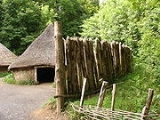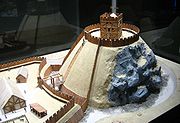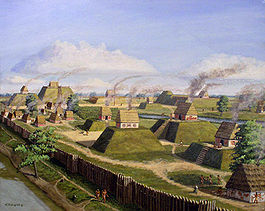
Palisade
Encyclopedia


Fence
A fence is a freestanding structure designed to restrict or prevent movement across a boundary. It is generally distinguished from a wall by the lightness of its construction: a wall is usually restricted to such barriers made from solid brick or concrete, blocking vision as well as passage .Fences...
or wall of variable height, usually used as a defensive structure.
Typical construction
Typical construction consisted of small or mid sized tree trunks aligned vertically, with no spacing in between. The trunks were sharpened or pointed at the top, and were driven into the ground and were sometimes reinforced with additional construction. The height of a palisade ranged from a few feet to nearly ten feet. As a defensive structure, palisades were often used in conjunction with earthworksEarthworks (engineering)
Earthworks are engineering works created through the moving or processing of quantities of soil or unformed rock.- Civil engineering use :Typical earthworks include roads, railway beds, causeways, dams, levees, canals, and berms...
.
Palisades were an excellent option for small forts or other hastily constructed fortifications. Since they were wood, they could be quickly and easily built from materials readily available. They proved to be effective protection for short-term conflicts, and were an effective deterrent against small forces. However, due to their wooden construction, they were also vulnerable to fire and siege weapons.
Often, a palisade would be constructed around a castle
Castle
A castle is a type of fortified structure built in Europe and the Middle East during the Middle Ages by European nobility. Scholars debate the scope of the word castle, but usually consider it to be the private fortified residence of a lord or noble...
as a temporary wall until a permanent stone wall could be erected. They were frequently used in New France
New France
New France was the area colonized by France in North America during a period beginning with the exploration of the Saint Lawrence River by Jacques Cartier in 1534 and ending with the cession of New France to Spain and Great Britain in 1763...
.
Ancient Greece and Rome
Both the GreeksAncient Greece
Ancient Greece is a civilization belonging to a period of Greek history that lasted from the Archaic period of the 8th to 6th centuries BC to the end of antiquity. Immediately following this period was the beginning of the Early Middle Ages and the Byzantine era. Included in Ancient Greece is the...
and Romans
Ancient Rome
Ancient Rome was a thriving civilization that grew on the Italian Peninsula as early as the 8th century BC. Located along the Mediterranean Sea and centered on the city of Rome, it expanded to one of the largest empires in the ancient world....
created palisades to protect their military camps. The Roman historian Livy
Livy
Titus Livius — known as Livy in English — was a Roman historian who wrote a monumental history of Rome and the Roman people. Ab Urbe Condita Libri, "Chapters from the Foundation of the City," covering the period from the earliest legends of Rome well before the traditional foundation in 753 BC...
describes the Greek method as being inferior to that of the Romans during the Second Macedonian War
Second Macedonian War
The Second Macedonian War was fought between Macedon, led by Philip V of Macedon, and Rome, allied with Pergamon and Rhodes. The result was the defeat of Philip who was forced to abandon all his possessions in Greece...
. The Greek stakes were too large to be easily carried, and were spaced too far apart. This made it easy for enemies to uproot them and create a large enough gap in which to enter. In contrast, the Romans used smaller and easier to carry stakes which were placed closer together, making them more difficult to uproot.
Precolumbian North America


Native Americans in the United States
Native Americans in the United States are the indigenous peoples in North America within the boundaries of the present-day continental United States, parts of Alaska, and the island state of Hawaii. They are composed of numerous, distinct tribes, states, and ethnic groups, many of which survive as...
Mississippian culture
Mississippian culture
The Mississippian culture was a mound-building Native American culture that flourished in what is now the Midwestern, Eastern, and Southeastern United States from approximately 800 CE to 1500 CE, varying regionally....
of the Southeastern United States
Southeastern United States
The Southeastern United States, colloquially referred to as the Southeast, is the eastern portion of the Southern United States. It is one of the most populous regions in the United States of America....
also made use of palisades. The most prominent example is the Cahokia Mounds site in Collinsville, Illinois
Collinsville, Illinois
Collinsville is a city located mainly in Madison County, and partially in St. Clair County, both in Illinois. As of the 2010 census, the city had a population of 26,016. Collinsville is approximately 12 miles from St. Louis, Missouri and is considered part of that city's Metro-East area...
. A wooden stockade with a series of watchtowers or bastion
Bastion
A bastion, or a bulwark, is a structure projecting outward from the main enclosure of a fortification, situated in both corners of a straight wall , facilitating active defence against assaulting troops...
s at regular intervals formed a 2 miles (3.2 km) enclosure around Monk's Mound
Monk's Mound
Monks Mound is the largest Pre-Columbian earthwork in America north of Mesoamerica. Located at the Cahokia Mounds UNESCO World Heritage Site near Collinsville, Illinois, its size was calculated in 1988 as about 100 feet high, 955 feet long including the access ramp at the southern end, and 775...
and the Grand Plaza. Archaeologists found evidence of the stockade during excavation of the area and indications that it was rebuilt several times, in slightly different locations. The stockade seems to have separated Cahokia's main ceremonial precinct from other parts of the city, as well as being a defensive structure.
Other examples include the Angel Mounds Site
Angel Mounds
Angel Mounds State Historic Site is located on the Ohio River in Vanderburgh and Warrick Counties eight miles southeast of Evansville and just upriver of the confluence of the Green and Ohio rivers. Administered by the Indiana Department of Natural Resources, Division of Indiana State Museums...
in Southern Indiana
Indiana
Indiana is a US state, admitted to the United States as the 19th on December 11, 1816. It is located in the Midwestern United States and Great Lakes Region. With 6,483,802 residents, the state is ranked 15th in population and 16th in population density. Indiana is ranked 38th in land area and is...
, Aztalan State Park
Aztalan State Park
Aztalan State Park is a Wisconsin state park located just south of the town of Aztalan, Wisconsin at latitude N 43° 4' and longitude W 88° 52', and established in 1952. It was also designated a National Historic Landmark in 1964 and added to the National Register of Historic Places in 1966...
in Wisconsin
Wisconsin
Wisconsin is a U.S. state located in the north-central United States and is part of the Midwest. It is bordered by Minnesota to the west, Iowa to the southwest, Illinois to the south, Lake Michigan to the east, Michigan to the northeast, and Lake Superior to the north. Wisconsin's capital is...
, the Kincaid Site
Kincaid Mounds State Historic Site
The Kincaid Mounds Historic Site, circa 1050-1400 CE, was among the largest prehistoric Mississippian culture chiefdom centers, located at the southern tip of present day U.S. state of Illinois...
in Illinois
Illinois
Illinois is the fifth-most populous state of the United States of America, and is often noted for being a microcosm of the entire country. With Chicago in the northeast, small industrial cities and great agricultural productivity in central and northern Illinois, and natural resources like coal,...
, the Parkin Site
Parkin Archeological State Park
Parkin Archeological State Park, also known as Parkin Indian Mound, is an archeological site and state park in Parkin, Cross County, Arkansas. Around 1350–1650 CE an aboriginal palisaded village existed at the site, at the confluence of the St. Francis and Tyronza Rivers. Artifacts from this...
and the Nodena Site
Nodena Site
The Nodena Site is an archeological site east of Wilson, Arkansas and northeast of Reverie, Tennessee in Mississippi County, Arkansas, United States. Around 1400–1650 CE an aboriginal palisaded village existed in the Nodena area on a meander bend of the Mississippi River. The Nodena site...
s in Southeastern Arkansas
Arkansas
Arkansas is a state located in the southern region of the United States. Its name is an Algonquian name of the Quapaw Indians. Arkansas shares borders with six states , and its eastern border is largely defined by the Mississippi River...
and the Etowah Site
Etowah Indian Mounds
Etowah Indian Mounds is a archaeological site in Bartow County, Georgia south of Cartersville, in the United States. Built and occupied in three phases, from 1000–1550 CE, the prehistoric site is located on the north shore of the Etowah River. Etowah Indian Mounds Historic Site is a designated...
in Georgia.
South Africa
In South AfricaSouth Africa
The Republic of South Africa is a country in southern Africa. Located at the southern tip of Africa, it is divided into nine provinces, with of coastline on the Atlantic and Indian oceans...
, a common means to prevent crime is for residential houses to have perimeter defences such as brick walls, steel palisade fences, wooden palisade fences and also electrified palisade fences. The City of Johannesburg
City of Johannesburg Metropolitan Municipality
The City of Johannesburg Metropolitan Municipality is a metropolitan municipality that manages the local governance of Johannesburg, South Africa...
promotes the use of palisade fencing over opaque, usually brick, walls as criminals cannot hide as easily behind the fence. In the City of Johannesburg manual on safety one can read about best practices and maintenance of palisade fencing, such as not growing vegetation in front of palisades as this allows criminals to make an unseen breach.

